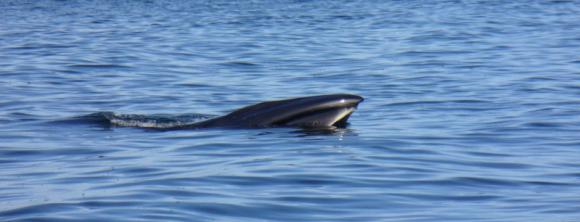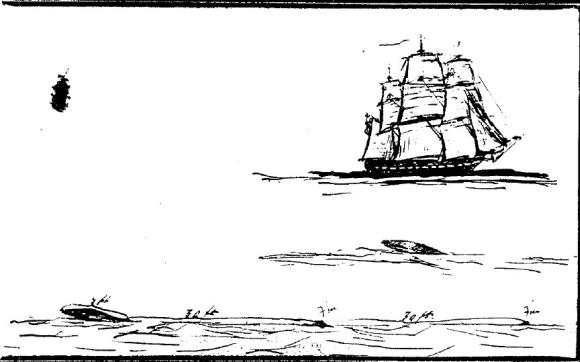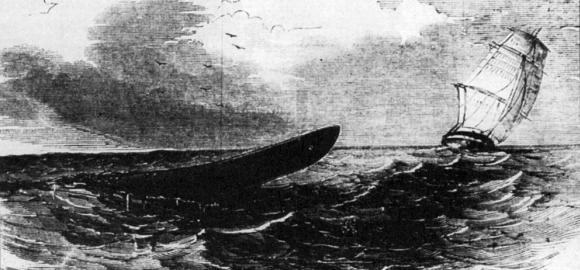 One of the most interesting accounts of a sea serpent is that of the HMS Daedalus in 1848. When sailing in the South Atlantic, some 300 miles from the coast of present-day Namibia, officers and crew aboard the ship saw what they described as an enormous serpent swimming with its head four feet above the water and roughly another sixty feet of the creature extending back in the sea. Captain McQuahoe also said that “[The creature] passed rapidly, but so close under our lee quarter, that had it been a man of my acquaintance I should have easily have recognized his features with the naked eye.” According to seven members of the crew, it remained in view for around twenty minutes. Lt. E.A. Drummond recorded the events in his diary the day he observed them and also made sketches of what he saw.
One of the most interesting accounts of a sea serpent is that of the HMS Daedalus in 1848. When sailing in the South Atlantic, some 300 miles from the coast of present-day Namibia, officers and crew aboard the ship saw what they described as an enormous serpent swimming with its head four feet above the water and roughly another sixty feet of the creature extending back in the sea. Captain McQuahoe also said that “[The creature] passed rapidly, but so close under our lee quarter, that had it been a man of my acquaintance I should have easily have recognized his features with the naked eye.” According to seven members of the crew, it remained in view for around twenty minutes. Lt. E.A. Drummond recorded the events in his diary the day he observed them and also made sketches of what he saw.
What makes the sighting so unusual is the length of the observation, the number of witnesses and that several Royal Navy officers were among that number. Three professional drawings of the creature, based on the captain’s account, were later published. Sketches made by Lt. Drummond finally turned up in 1977.
The captain and the lieutenant agreed reasonably closely on what they observed. From Lt. Drummond’s diary:
H. M. S. Daedalus, August, 6, 1848, lat. 25° S., long 9° 37′ E., St., Helena 1015 miles. In the 4 to 6 watch, at about five o’clock, we observed a most remarkable fish on our lee quarter, crossing the stern in a S. W. direction; the appearance of its head, which, with the back fin, was the only portion of the animal visible, was long, pointed, and flattened at the top, perhaps ten feet in length, the upper jaw projecting considerably; the fin was perhaps twenty feet in the rear of the head, and visible occasionally; the captain also asserted that he saw the tail, or another fin about the same distance behind it; the upper part of the head and shoulders appeared of a dark brown colour, and beneath the under jaw a brownish white. It pursued a steady undeviating course, keeping its head horizontal with the surface of the water, and in rather a raised position, disappearing occasionally beneath a wave for a very brief interval, and not apparently for purposes of respiration. It was going at the rate of perhaps from twelve to fourteen miles an hour, and when nearest, was perhaps one hundred yards distant. In fact it gave one quite the idea of a large snake or eel. No one in the ship has ever seen anything similar, so it is at least extraordinary. It was visible to the naked eye for five minutes, and with a glass for perhaps fifteen more. The weather was dark and squally at the time, with some sea running.
So, what did the officers and crew of HMS Daedalus see? There have been numerous candidates proposed — a plesiosaur, an elephant seal, an oarfish, a whale shark, an undiscovered giant eel, among others. None terribly plausible nor convincing.
Four years ago, Gary J. Galbreath writing in the Skeptical Inquirer came up with the most likely explanation. He suggests that those aboard HMS Daedalus saw a sei whale skim feeding on the surface.

Sei whale at the surface. Photo from http://www.planetwhale.com/boat-767_HEBRIDEAN_WHALE_CRUISES_Whale_Dolphin_Watching
Sei whales can be up to 60 feet long and are baleen whales. When skim feeding along the surface, their upper jaw protrudes above the water and the baleen plates extending below it are lighter in color corresponding to the reported white underside of the Daedalus serpent. The dorsal fin of the sei whale also is in roughly the same location as the fin reported and sketched by Lt. Drummond.
The sketches for Captain McQuahoe, prepared some months after the fact, clearly, reflect his perspective that he saw a sea serpent. Lt. Drummond’s sketch, on the other hand, is more detailed and naturalistic and looks potentially far more like a sei whale.

Lt. Drummond’s sketch, showing head, dorsal fin and estimated lengths
Interesting enough, the sea serpent of HMS Daedalus, or perhaps its cousin, was again observed about a year later from the deck of HMS Plumper when cruising off the Portuguese coast. The sketch of the “long black creature” as it appeared in the Illustrated London News, of 14 April 1849, to my eye looks very much like the upper jaw of a sei whale. Perhaps a sei monster, indeed.


Learn something new. Thankyou Rick.
Sei Whale
The third largest whale species after blue whales and fin whales, sei whales are one of the most poorly understood of all baleen whales. Although they were heavily hunted in the modern whaling era, their current distribution, migration patterns and behaviour are not well studied. Two sub-species are recognized: B. b. schlegelii in the Southern Hemisphere and B. b. borealis the Northern Hemisphere1. Due to their primarily offshore distribution and their unpredictable seasonal movements, sei whales are not often the main target of whale watching activities. However, they can be observed during whale watching tours where their seasonal habitat overlaps with that of more predictable species like humpback whales, gray whales or minke whales.
The anonymous ‘Officer’ (1858) wrote that the animal was moving at probably not less than ten miles per hour, that water was surging under its chest, that it was not more than 200 yards away at its closest position, that it was in sight for about ten minutes, and that “the eye, the mouth, the nostril, the colour and form” were all distinctly visible. It should be noted that he was writing nearly a decade after the event, and may have been influenced by the writings and authorized drawings of his captain.